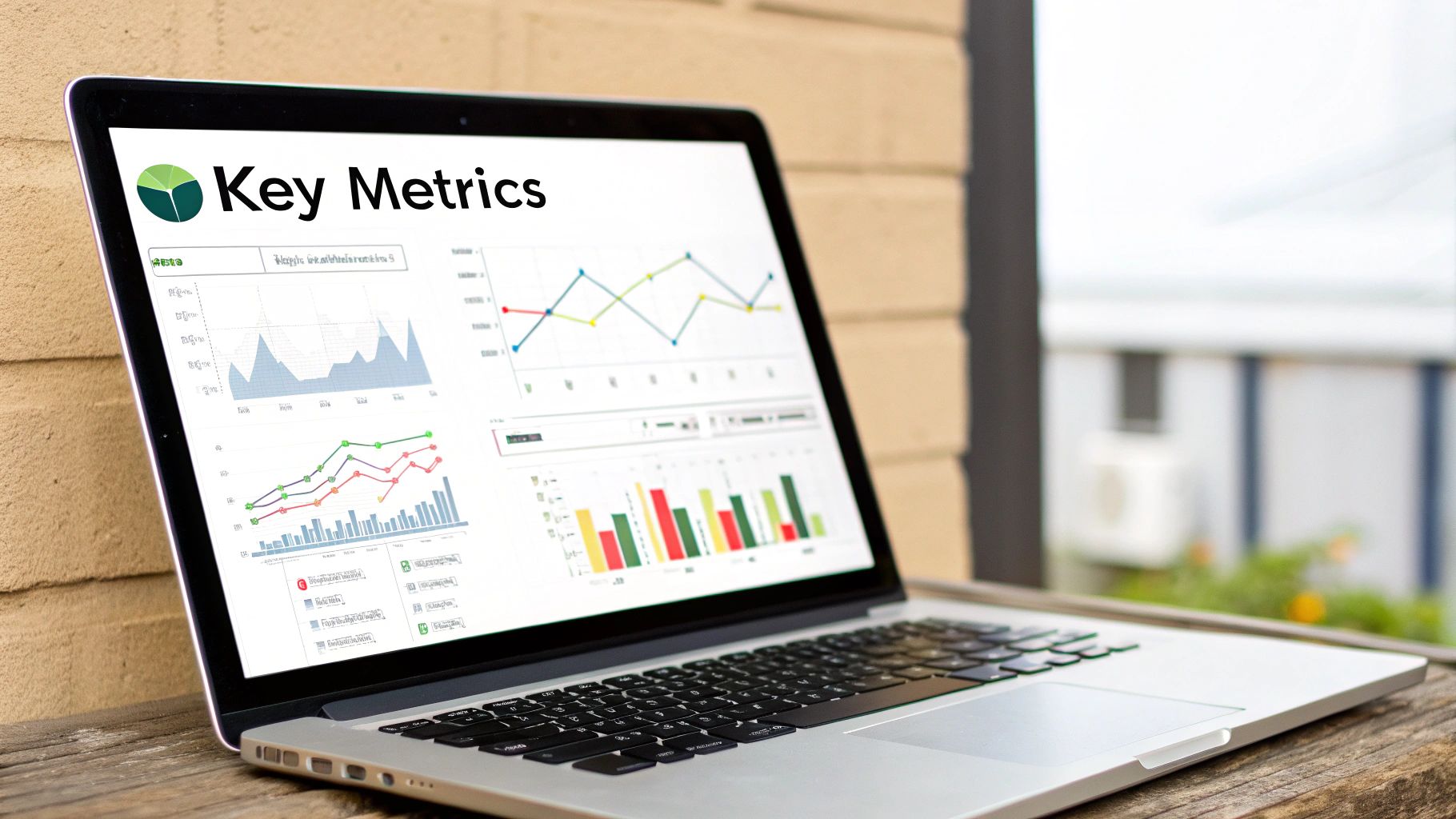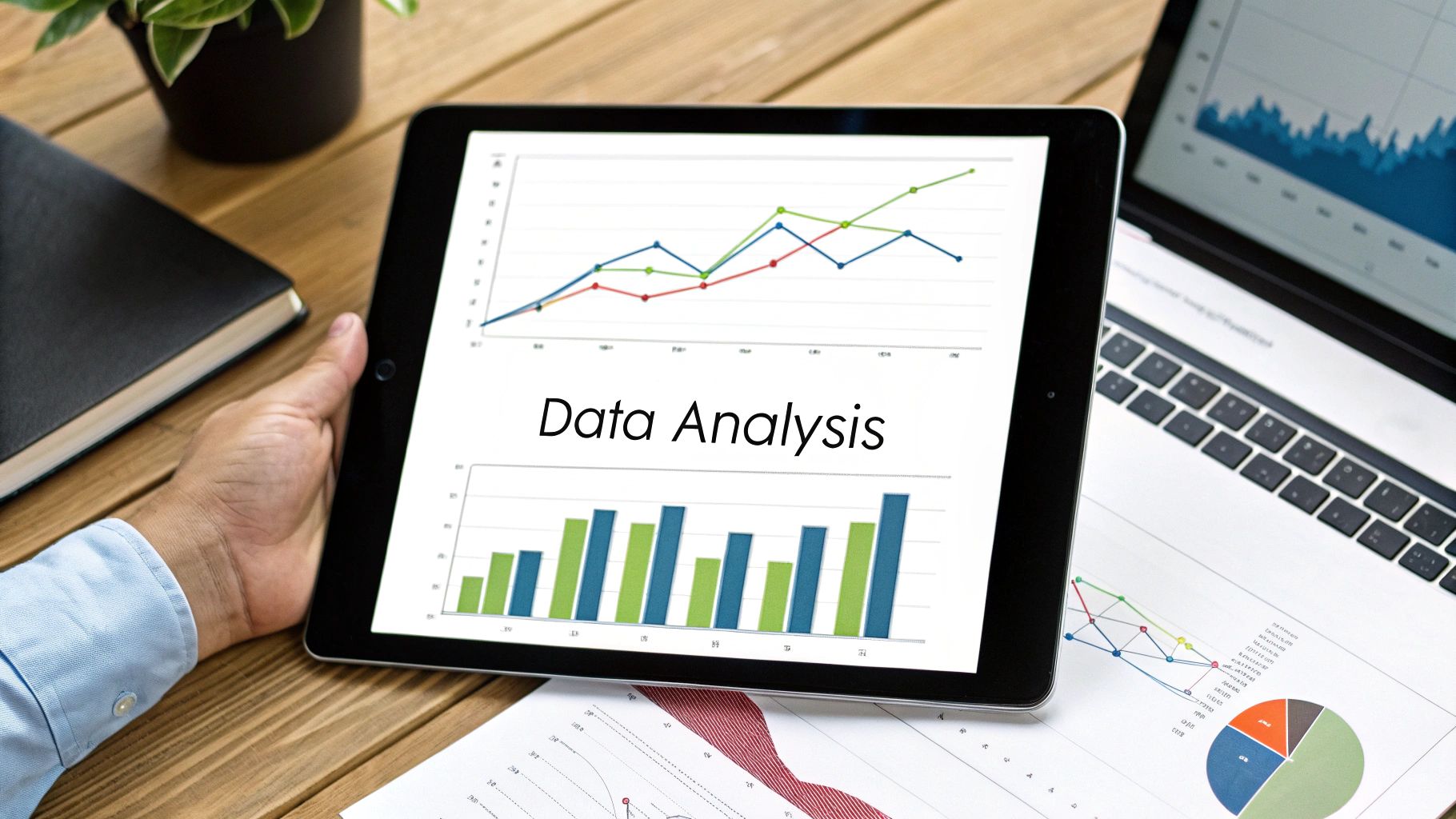Understanding Product Performance Dashboards
Product performance dashboards are now vital tools for businesses that prioritize data-driven decision-making. Think of them as central hubs, converting raw data into usable insights. Instead of sorting through scattered metrics, product leaders can use these dashboards to get a clear picture of how their products are performing. This allows for more informed decisions and quicker responses to market shifts. In essence, a good product performance dashboard narrates your product’s progress and performance.
Types of Product Performance Dashboards
There are several types of dashboards, each designed for a specific purpose:
-
Operational Dashboards: These provide a real-time view of your product's daily performance. They highlight key operational metrics, enabling teams to quickly identify and address any immediate problems.
-
Strategic Dashboards: Offering a high-level overview, strategic dashboards monitor progress toward long-term objectives. They help leadership teams grasp the bigger picture and make strategic decisions.
-
Analytical Dashboards: These dashboards are built for in-depth analysis of specific data sets. They allow analysts to explore trends, identify root causes of issues, and discover hidden opportunities.
Understanding when to use each type is critical for maximizing their effectiveness. For instance, an operational dashboard might monitor daily active users, while a strategic dashboard might focus on monthly recurring revenue. You might be interested in: Our sitemap.
Solving the Data Fragmentation Problem
Many organizations grapple with data fragmentation, a situation where information is spread across various systems and departments. This makes obtaining a complete and accurate understanding of product performance a real challenge. Product performance dashboards tackle this by creating a single source of truth. They consolidate data from multiple sources, presenting a unified view of key metrics. This streamlines reporting and empowers teams to confidently make data-driven decisions.
For example, the UK's Office for National Statistics (ONS) developed a performance dashboard with six KPIs to track service delivery. This focused on metrics like search exits and user engagement. This initiative emphasized the value of user feedback and iterative development when measuring non-transactional services. Learn more about the ONS dashboard here: Introducing our new performance dashboard.

A well-designed product performance dashboard offers a clear, concise, and actionable overview of product performance, enabling data-driven decisions that ultimately drive product success. It's not just about visualizing data; it's about transforming data into a story that informs and motivates action. This helps filter out the noise and focus on the metrics that matter most.
Selecting Metrics That Actually Matter
Not all metrics offer the same value. While a large quantity of data might seem beneficial, a truly effective product performance dashboard focuses on metrics that directly influence business decisions. It’s important to avoid vanity metrics, which are data points that look good superficially but don't offer actionable insights.
Instead, concentrate on metrics aligned with your business objectives and contribute to strategic decision-making. This requires developing a balanced scorecard across various key areas.
Key Performance Indicators (KPIs) for Your Dashboard
Creating a robust product performance dashboard necessitates a strategic approach to metric selection. This involves understanding which KPIs offer the most relevant insights across different facets of your product's performance.
-
Acquisition: Understanding where your users originate is critical. Key metrics include website traffic, conversion rates, and customer acquisition cost (CAC). Analyzing these metrics helps optimize marketing campaigns and refine targeting efforts.
-
Engagement: How users interact with your product is another crucial area. Metrics such as daily/monthly active users (DAU/MAU), session duration, and feature usage reveal how users experience your product. This data is essential for pinpointing areas for improvement and enhancing user experience.
-
Retention: Keeping users engaged over time is a sign of a successful product. Metrics like customer churn rate, customer lifetime value (CLTV), and retention rate help measure the long-term viability of your product. Understanding these can help identify pain points and foster customer loyalty.
-
Revenue: Tracking how your product generates value is paramount. Metrics like average revenue per user (ARPU), monthly recurring revenue (MRR), and conversion rates directly reflect the financial performance of your product, helping identify growth opportunities and ensure profitability.
-
Quality: User perception significantly impacts product success. Metrics like customer satisfaction (CSAT) scores, Net Promoter Score (NPS), and app store ratings provide valuable insights into user sentiment. This feedback is essential for enhancing product quality and addressing user concerns.
Metric Selection Across the Product Lifecycle
The ideal metrics for your product performance dashboard will change depending on the product lifecycle stage. Early-stage products may focus on acquisition and engagement, while mature products may prioritize retention and revenue. A newly launched app might prioritize daily active users, whereas a mature SaaS product might focus on customer lifetime value.
To better understand the relevant metrics for different business functions, consider the following table:
Essential Product Performance Metrics by Category
A comprehensive breakdown of key metrics organized by business function, showing which metrics matter most for different aspects of product performance.
| Metric Category | Key Metrics | Business Impact | Ideal Frequency |
|---|---|---|---|
| Acquisition | Website Traffic, Conversion Rates, Customer Acquisition Cost (CAC) | Measures marketing campaign effectiveness and targeting accuracy. | Weekly/Monthly |
| Engagement | Daily/Monthly Active Users (DAU/MAU), Session Duration, Feature Usage | Identifies areas for product improvement and user experience enhancement. | Daily/Weekly |
| Retention | Customer Churn Rate, Customer Lifetime Value (CLTV), Retention Rate | Measures long-term product success and customer loyalty. | Monthly/Quarterly |
| Revenue | Average Revenue Per User (ARPU), Monthly Recurring Revenue (MRR), Conversion Rates | Reflects financial performance and identifies growth opportunities. | Weekly/Monthly |
| Quality | Customer Satisfaction (CSAT) Scores, Net Promoter Score (NPS), App Store Ratings | Provides insights into user perception and identifies areas for product quality improvement. | Ongoing/Periodic |
This table highlights the relationship between specific metrics and their corresponding impact on different business areas, providing a framework for selecting the most relevant KPIs for your product performance dashboard.
Real-World Examples and Data-Driven Decisions
Successful companies recognize the value of leveraging the right metrics for competitive advantage. For example, a social media platform might track daily active users and average session duration to gauge user engagement, allowing adjustments to content strategy and improvements to the user experience. Similarly, an e-commerce business might monitor conversion rates and average order value to optimize its sales funnel and boost revenue.
News UK, for instance, adopted a KPI dashboard that combines financial metrics with customer engagement indicators like article dwell time and average session length, enabling real-time strategy adjustments based on customer behavior. Learn more about their approach: Discover more insights about data-driven decision-making.

By focusing on relevant metrics and adapting your dashboard to the evolving needs of your product, you can transform it into a powerful tool for growth and success.
Crafting Dashboards That Drive Action
A visually appealing product performance dashboard that gathers dust represents wasted potential. This section explores the psychology and design principles that transform static data displays into dynamic decision-making tools. We'll examine the crucial balance between comprehensive data and instant clarity, ensuring your dashboard is a valuable resource, not an overwhelming mass of information.
Visual Hierarchy and Clarity
Establishing a clear visual hierarchy is paramount. It guides the user's eye to the most critical insights first, preventing them from becoming lost in a sea of data. Think of a newspaper: the headline grabs attention, followed by subheadings and then the body text. A well-designed dashboard uses size, color, and placement to prioritize key metrics. For example, displaying your most important KPI in a large, bold font at the top center immediately communicates its significance.
Choosing the right chart type for each metric is also crucial. A line chart excels at showing trends over time, while a pie chart effectively displays proportions. Using the wrong chart can obscure data and lead to misinterpretations.
Progressive Disclosure: Preventing Information Overload
Progressive disclosure is a powerful technique for managing complex datasets. It presents only the most essential information upfront, allowing users to drill down for more details as needed. This keeps the initial view clean and uncluttered, preventing information overload. Like an online map starting with a broad overview and allowing users to zoom in for street-level detail, clicking a specific metric on a product performance dashboard could reveal a detailed breakdown of its components.
For example, the UK government's great.gov.uk performance dashboard aimed to provide insights into digital service usage. Recent updates plan to transition from general statistics to specific management information on individual products. This shift towards granular data focuses on metrics like digital take-up and user satisfaction, aligning with the Government Digital Service (GDS) Service Standard 10. Explore this further: Find more detailed statistics here.
Predictive Power: Anticipating the Future
Forward-thinking teams incorporate predictive elements into their product performance dashboards. Combining historical data with predictive modeling, these dashboards not only show what happened but also anticipate what's likely to happen next. This proactive approach allows for more informed decisions and quicker responses to emerging trends. Like a weather forecast using past patterns to predict future conditions, a product performance dashboard could use past sales data to forecast future demand.

By embracing these principles, you can transform your product performance dashboard from a static report into a dynamic tool that drives meaningful action and fuels product success. The ultimate goal isn't just to display data, but to empower informed decisions that propel your product forward.
Choosing the Right Dashboard Technology
Selecting the right technology for your product performance dashboard is crucial for maximizing its effectiveness. With many options available, it's essential to look beyond marketing and focus on your specific needs. This involves carefully evaluating the strengths and limitations of different technologies, from Business Intelligence (BI) platforms to flexible visualization libraries.
Business Intelligence Platforms: Customization and Complexity
BI platforms offer powerful features for data analysis and visualization. They allow extensive customization, enabling you to tailor dashboards to your exact specifications. However, this flexibility often comes with increased complexity. BI platforms like Tableau typically require specialized skills to implement and maintain, potentially demanding dedicated resources within your organization. They are best suited for larger organizations with dedicated data teams and complex data requirements.
Product Analytics Tools: Ease of Use and Limitations
Product analytics tools prioritize ease of use and quick setup. They often come with pre-built dashboards and intuitive interfaces, making them accessible to a broader range of users. However, this ease of use may come at the expense of customization. Product analytics tools like Mixpanel may not offer the same level of flexibility as BI platforms, potentially limiting your ability to tailor dashboards to specific needs. These tools are often ideal for smaller teams and startups looking for rapid insights without heavy technical investment. You might be interested in: Learn more in our article about our sitemap.
Visualization Libraries: Flexibility and Technical Overhead
Visualization libraries offer maximum flexibility for creating bespoke dashboards. These code-based tools, such as D3.js, empower developers to build highly customized visualizations. However, this flexibility requires significant technical expertise. Implementing and maintaining dashboards built with visualization libraries requires dedicated development resources and ongoing maintenance. They are best suited for organizations with strong development teams and a need for highly specialized visualizations.
Custom Solutions: Perfect Fit and Resource Intensity
Building a custom dashboard solution from scratch provides a perfect fit for your unique requirements. This allows complete control over every aspect of the dashboard, from data sources to visualizations. However, custom development is resource-intensive, demanding both time and financial investment. It's crucial to carefully weigh the benefits of a perfect fit against the significant investment required for custom development. This approach is generally reserved for organizations with highly specific needs that cannot be met by off-the-shelf solutions.
Key Considerations For Choosing a Technology
Beyond the core features of each technology, consider factors like data refresh rates, API limitations, and security requirements. Real-time data updates are essential for operational dashboards, while less frequent updates may suffice for strategic dashboards. API limitations can impact data integration and automation capabilities. Robust security features are crucial for protecting sensitive data.
To help you choose the right dashboard tool, let's look at a comparison of some popular options:
The following table provides a detailed comparison of popular dashboard creation tools:
| Tool | Best For | Pricing Model | Integration Capabilities | Learning Curve | Customization Level |
|---|---|---|---|---|---|
| Tableau | Enterprise-level analytics and visualization | Subscription | Extensive | Moderate to High | High |
| Power BI | Business users and analysts | Subscription | Good | Moderate | Medium |
| Google Data Studio | Marketing and web analytics | Free | Good | Easy | Medium |
| D3.js | Highly customized visualizations | Open-source | Requires coding | High | Very High |
| Custom Solutions | Unique, highly specialized needs | Varies | Dependent on implementation | Dependent on implementation | Very High |
As you can see, the "best" tool truly depends on your specific needs and resources. Consider your team's technical skills, budget, and the level of customization required when making your decision.
Performance dashboards in the UK benefit from specialized services offering data visualization and management. Services available on the Digital Marketplace, for example, provide comprehensive tools for integrating and analyzing datasets, enabling real-time monitoring and decision-making. These solutions adhere to GOV.UK standards, ensuring security and compliance. Find more detailed statistics here: Explore this topic further.

By carefully considering these factors and aligning them with your specific needs, you can choose the dashboard technology that empowers you to transform data into actionable insights. This will create a product performance dashboard that drives meaningful decisions and contributes to your product's success.
Transforming Dashboards into Decision Engines
Many product performance dashboards become unused, like digital decorations, instead of the valuable tools they should be. The key to maximizing their value is integrating them into your organization's daily operations. This means creating a data-driven culture, defining clear accountability, and establishing consistent review processes.
Establishing Effective Review Cadences
Using a product performance dashboard effectively requires regular reviews. Establish clear schedules for reviewing dashboard insights at different organizational levels. Daily operational check-ins allow teams to address immediate problems. Weekly reviews track progress toward short-term goals. Monthly reviews provide a broader performance overview. Quarterly strategic reflections allow leadership to adjust long-term strategies based on data trends. For example, a daily stand-up meeting could include a quick review of key operational metrics from the dashboard, allowing the team to identify and address any immediate bottlenecks.
Setting Actionable Alert Thresholds
Setting appropriate alert thresholds is crucial for preventing alert fatigue. Alerts should flag important issues that require action, not overwhelm teams with constant notifications. Carefully consider the normal fluctuation range of your metrics. A 10% drop in daily active users, for example, might warrant an immediate investigation, while a 2% fluctuation might be within the normal range. This thoughtful approach ensures alerts remain effective and trigger timely responses when necessary.
Creating a Data-Driven Culture
A data-driven culture requires more than just having a dashboard. It means actively using data to inform decisions at all levels. This requires clear governance frameworks that define how data is collected, analyzed, and used. Accountability mechanisms ensure individuals are responsible for acting on dashboard insights. Assigning ownership of specific metrics to team members, for example, ensures someone monitors performance and takes corrective action when necessary.
Fostering Cross-Functional Collaboration
Using product performance dashboards effectively often requires cross-functional collaboration. Share relevant dashboard insights with different departments and teams. Sharing revenue data with the marketing team, for instance, can inform their campaign strategies. Sharing user feedback with the product development team can influence future product improvements. This collaborative approach keeps everyone aligned and working toward common goals. This shared understanding fosters more effective problem-solving and better overall results. Through these practices, dashboards transform into powerful decision engines, guiding strategy and driving product success.
Overcoming Product Dashboard Pitfalls
Product performance dashboards, while powerful tools, aren't guaranteed to succeed. Even with the best of intentions, dashboard projects can encounter various challenges. This section explores common pitfalls, drawing on insights from analytics experts, and offers practical solutions to help you navigate these obstacles and build truly effective dashboards.
Breaking Down Data Silos
One of the biggest hurdles is data silos. Having information scattered across various systems and departments creates a fragmented view of product performance. Overcoming this doesn't always require large infrastructure investments. Start by identifying key data sources and exploring ways to integrate them, even in small steps. For example, connecting your CRM with your product analytics tool can create a single, unified view of customer behavior and revenue.
Ensuring Data Quality and Trust
A product performance dashboard is only as good as the data it presents. Data quality issues can erode trust and make insights meaningless. Implement data quality safeguards, such as automated validation checks and regular data audits, to maintain accuracy. This builds confidence in the data and encourages informed decision-making.
Dashboard Literacy Across Stakeholders
Even the best-designed dashboard is useless if stakeholders can't understand the data. Invest in dashboard literacy training to ensure everyone understands the metrics and how to use them. This empowers all stakeholders to draw meaningful conclusions and contribute to data-driven discussions. It's like providing a map and compass; without training, people won't know how to navigate effectively. Check out our guide on navigating our sitemap for additional resources.
Balancing Standardization and Customization
Finding the right balance between standardization and customization is key. Standardized dashboards ensure consistency across the organization, while customized dashboards cater to the specific needs of individual teams. A practical approach is to create standardized templates with customizable elements. This provides a consistent framework while allowing for individual adjustments. This is similar to modular furniture, where a standard frame allows for different configurations based on individual needs.
Incorporating Qualitative Insights
While quantitative metrics are essential, don't overlook the value of qualitative insights. Integrate user feedback, customer surveys, and market research data to offer a more complete understanding of product performance. For example, a dashboard showing high customer churn could be supplemented by user feedback explaining the reasons behind this trend.
Adapting for Distributed Teams
With the rise of remote work, dashboards need to support distributed teams. Choose a platform that allows for real-time data access and has collaboration features. This ensures everyone has the same up-to-date information, no matter where they are. This promotes informed decisions and consistent actions across the whole team.
Overcoming Resource Constraints
Implementing and maintaining a product performance dashboard requires resources. Prioritize features based on their impact and feasibility. Start with a minimum viable dashboard (MVD) focusing on the most important metrics and gradually expand its capabilities as resources permit.
By recognizing and addressing these pitfalls proactively, you can transform your product performance dashboard into a valuable decision-making tool. This allows you to unlock the full potential of your data and achieve your product goals.
Ready to transform your TikTok Shop sales data into actionable insights and optimize your profitability? Explore real-time analytics and predictive modeling with Mergoio, the comprehensive dashboard designed for data-driven e-commerce success. Join our beta program today and experience the future of profit tracking.

Leave a Reply